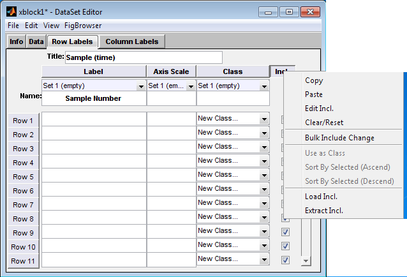DataSet Editor Window: Layout: Difference between revisions
imported>Scott |
imported>Scott No edit summary |
||
| Line 274: | Line 274: | ||
| | | | ||
* Hard Delete Excluded-Permanently removes excluded data from a DataSet object. | * Hard Delete Excluded - Permanently removes excluded data from a DataSet object. | ||
|} | |} | ||
| Line 294: | Line 294: | ||
| | | | ||
* Transpose-Switches the rows and columns for a 2-way DataSet object. | * Transpose - Switches the rows and columns for a 2-way DataSet object. | ||
|} | |} | ||
| Line 312: | Line 312: | ||
| | | | ||
* Permute modes-Changes the order of the data modes (dimensions). | * Permute modes - Changes the order of the data modes (dimensions). | ||
|} | |} | ||
Revision as of 19:09, 14 March 2012
Table of Contents | Previous | Next
DataSet Editor Window
The DataSet Editor window is the standard interface that you use for creating and managing a DataSet in Solo. Multiple options are available for opening the DataSet Editor window. You can:
|
|
|
|
|
DataSet Editor window layout
- DataSet Editor window
The DataSet Editor window has three major components-the title bar, the main menu, and the tabs.
|
- Note: If you launch the DataSet Editor window any other way than from an analysis window, and then modify the DataSet in any way, an asterisk (*) is displayed next to the DataSet name in the title bar. The asterisk indicates that modifications to the data are pending. Before you can close the DataSet Editor window, you must answer a prompt about saving the modified data. If you launch the DataSet Editor window from an analysis window, any modifications that you make to the data are immediate (no asterisk is displayed next to the DataSet name in the title bar) and you can close the window without having to answer a prompt about saving the data.
|
|
|
Info tab
When the DataSet Editor window opens, the Info tab is the active tab. (See the figure above.) The Info tab provides a high-level overview of the DataSet, including the DataSet name, the DataSet author, the data type and size in the DataSet for both included and excluded data, the DataSet creation date and time, the DataSet modification date and time, and a description of the DataSet.
The Info tab is interactive:
Plot tab
The Plot tab opens a plot of the data. This plot is linked to the DataSet Editor and will reflect selections made in either window.
Data tab
The Data tab displays the data in the DataSet in a spreadsheet format.
- DataSet Editor window, Data tab
The tab is interactive. You can:
|
|
|
|
All actions are available either from the Edit menu, or by right-clicking on a row or on a column header (as shown in the figure above) to open a context menu.
Row Labels tab/Column Labels tab
In a typical two-way DataSet, data mode 1 (the rows) represents the data samples and data mode 2 (the columns) represents the variables. The Row Labels tab and the Columns Labels tab-also known as the Mode Labels-provide access to the auxiliary "context" data for the Dataset, such as the labels for each sample, the axis scale, the classes, and the Include status for data. (Multi-way data has Label tabs for each mode of the data.)
- DataSet Editor window, Row Labels tab
You use the information in these fields for:
- Managing the data. (For example, the Include field indicates whether a given row or column is to be included in an analysis.)
- Plotting the data (For example, some correction algorithms plot against the axis scale of the columns.)
- Analyzing the data. (For example, classification algorithms use the information in the Class field to identify class assignments.)
A variety of options are available for specifying and working with the information for these fields. You can:
- Manually enter the information in each field.
- Assign a name to a field set to assist in identifying content.
- Create sets for loading multiple versions of a field into a single DataSet.
- Load the fields from files or variables in the base workspace (as long as the information that is being loaded is of the correct size.)
- Note: When you load field information from one DataSet object (the source DataSet) into another DataSet (the target DataSet), the information is always loaded from the corresponding field and mode (row/column) of the source DataSet. To load information from a different mode, you must first Extract or Copy the contents from the source DataSet object, and then Load or Paste the content into the target DataSet object. You can always load or paste information from a non-DataSet object, even when the information is from an external program such as Microsoft Excel.
- Copy and paste information to and from the Label field, the Axis Scale field, the Classes field, and the Include field.
- Edit multiple fields in a single step.
All actions are available either from the Edit menu, or by right-clicking on a row or on a column header (as shown in the figure above) to open a context menu.
See also:
The DataSet Editor Edit menu has many powerful data manipulation options. Some of the more commonly used options include the following:
|
|
|
|
|
|
Operations that involve transforming data can be found in this menu. Come tasks are:
|
|
|
|
|
|


